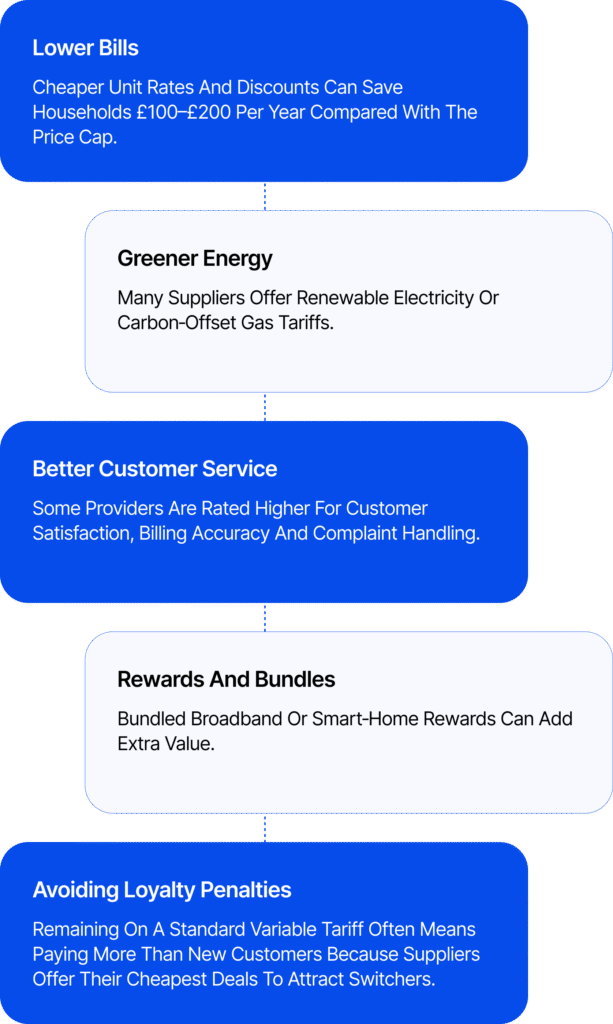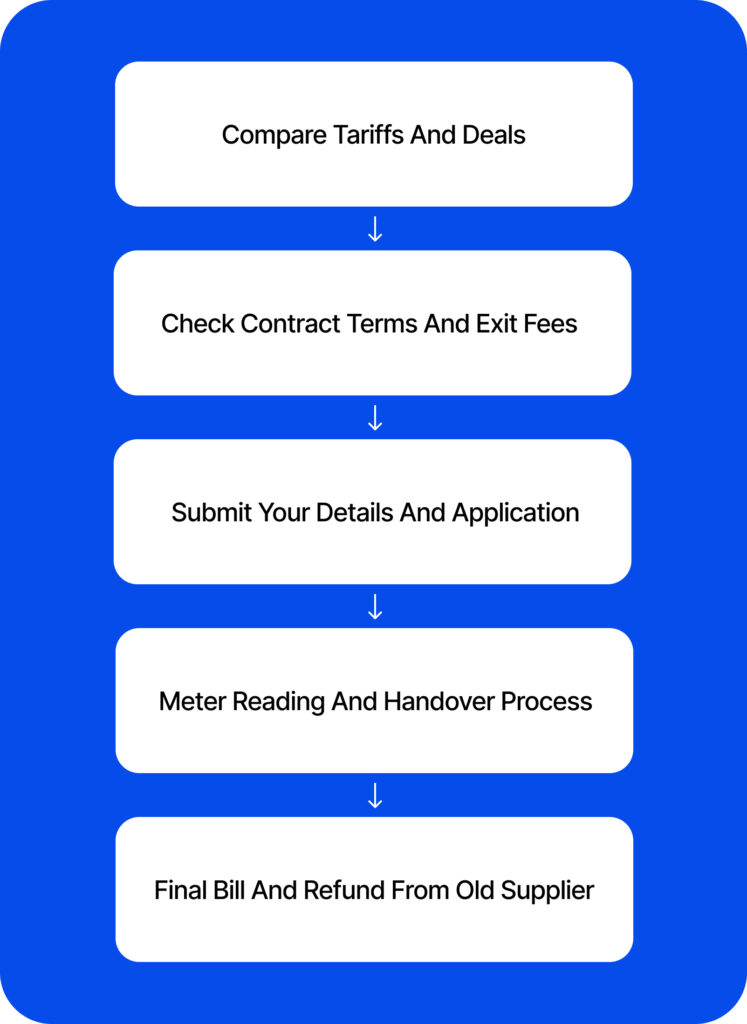Want cheaper energy bills? Learn how to switch suppliers in the UK, save money, and avoid mistakes. Step‑by‑step guide with pros, cons, and tips.
The days of set-and-forget energy deals are over. Prices still move, offers change fast, and the right switch can make a measurable dent in your monthly outgoings. The good news: the process is simple, protected by clear rules, and usually completed within days.
In this guide, you’ll learn how to switch energy supplier with confidence, from comparing tariffs and checking exit fees to meter readings and the final bill. We’ll show typical savings, highlight the traps that trip people up, and explain what to do if a supplier gets it wrong, including how to use small claims to recover what you’re owed.
Why Switch Energy Suppliers?
Rising Energy Prices in the UK
The UK’s energy market has seen turbulent prices since the pandemic and the war in Ukraine. Although wholesale costs have fallen from the 2022 peak, prices remain high by historical standards. The energy regulator Ofgem introduced an energy price cap in 2019 to limit the unit rate and standing charge suppliers can levy. For a typical dual‑fuel household paying by direct debit, the price cap fell from £1,849 to £1,720 between July and September 2025. From 1 October 2025, it will rise slightly to £1,755. The cap is reviewed every three months and is not a cap on your total bill; your costs still depend on how much energy you use.
High standing charges and unit rates mean many households on standard variable tariffs pay more than necessary. Switching to a cheaper supplier or tariff can reduce costs dramatically. Some fixed deals in August 2025 were 17% more affordable than the cap, and electricity‑only fixes could be 14.5% cheaper. There are also discounted variable tariffs that track the price cap but reduce the unit rate or standing charge by £50–£100 per year.
How Competition Works in the Energy Market
The UK energy market is competitive. Dozens of suppliers offer different tariffs, from large incumbents to new green providers. Competition encourages innovation, such as digital billing, renewable tariffs and customer rewards. Ofgem’s Energy Switch Guarantee ensures that customers can switch to a new tariff within five working days. The new supplier handles the entire transfer; there is a 14‑day cooling‑off period, and any credit owed by the old supplier is refunded within 14 days. This guarantee gives consumers confidence to shop around. Common reasons people switch:

Can You Still Switch Energy Suppliers in 2025?
Energy Price Cap and Ofgem Rules
You can switch suppliers even when energy prices are volatile. Ofgem’s price cap continues to protect consumers by limiting the unit rate and standing charge. For July-September 2025, the cap sets electricity at 25.73 p/kWh and gas at 6.33 p/kWh, with standing charges of 51.37 p/day for electricity and 29.82 p/day for gas. From October 2025, the cap rises slightly to 26.35 p/kWh for electricity and 6.29 p/kWh for gas, with standing charges of 53.68 p/day and 34.03 p/day. Ofgem updates these figures quarterly; switching helps you benefit when tariffs fall faster than the cap.
Restrictions During Fixed Contracts
If you are on a standard variable tariff, you can switch at any time. For fixed tariffs, you can usually switch without paying an exit fee once you are within the last 49 days of your contract. If you leave earlier, an exit fee, often £50–£75 per fuel, may apply. Consider whether the savings from a cheaper tariff outweigh any fees. People who owe money may also face restrictions: if you owe your supplier money for less than 28 days, you can switch, and the debt will be added to your final bill. But if you have been in debt for more than 28 days, you must repay the debt before switching. Prepayment customers can switch if they owe up to £500 per fuel.
Switching After Moving House
When you move, your energy contract does not automatically transfer. Contact your current supplier to provide a final meter reading and settle your account. Then compare tariffs at your new address. If you are renting and your landlord pays the energy bill, you will not be able to switch yourself; ask the landlord to do it. If the property is on a heat network, you cannot switch suppliers; instead, challenge the bill if it seems wrong. Many suppliers offer specific deals for movers; these can be cheaper than default tariffs.
Step‑by‑Step Guide to Switching Suppliers
Switching is straightforward. Follow this guide to ensure a hassle‑free change.

- Compare tariffs and deals – Use a price comparison website or your supplier’s online tools. Check both fixed and variable tariffs. Look for deals that are below the price cap or offer perks such as renewable energy or no exit fees. Make sure to use your annual energy usage (in kWh) to get accurate quotes. A typical household uses around 11,500 kWh of gas and 2,700 kWh of electricity per year.
- Check contract terms and exit fees – Identify how much time is left on your current contract and whether exit fees apply. If your fixed tariff ends soon, you can switch without paying fees.
- Submit your details and application – Once you’ve chosen a tariff, provide your personal details, meter type and payment method. The new supplier will handle the process under the Energy Switch Guarantee. You will receive a cooling‑off period of 14 days during which you can change your mind.
- Meter reading and handover process – On the switch date, send meter readings to both your old and new suppliers. This ensures you are billed accurately. If you have a smart meter, the reading may be taken automatically.
- Final bill and refund from old supplier – After the switch, your old supplier sends a final bill. Any credit must be refunded within 14 days. If you are owed money or feel you have been misbilled, contact your supplier immediately.
How Much Can You Save by Switching?
Factors Affecting Savings
Savings depend on several factors:
- Tariff type: Fixed tariffs may undercut the price cap by 10–17%, while discounted variable tariffs offer smaller but flexible savings.
- Payment method: Direct debit tariffs often have lower unit rates than standard credit or prepayment deals. Ofgem noted that many customers still pay by standard credit and could save around £135 a year by switching to direct debit.
- Energy consumption: High‑use households stand to save more in absolute terms because a lower unit rate multiplies across more kWh.
- Region and meter type: Standing charges and unit rates vary by region. Smart‑meter time‑of‑use tariffs can reduce costs for households that shift consumption off‑peak.
- Exit fees: Pay attention to exit fees when calculating savings. A cheap fix with high exit fees may be less attractive if prices fall.
Average Savings for Households
Exact savings vary, but price‑comparison data suggests households can typically save between £50 and £200 per year by switching from a standard variable tariff to a competitive fixed or discounted variable tariff. For example, a 12‑month dual‑fuel fix in August 2025 was about 17 % cheaper than the price cap. With the cap at £1,720, a 17% discount equates to a saving of about £292 a year. A no‑exit‑fee fix, 3.4 % cheaper than the cap, would save about £58. An electricity‑only fix, 14.5% cheaper, would save households without gas £248 annually.
Example Savings by Household Size and Tariff
| Household size | Typical annual consumption (kWh) | Price‑cap cost (July–Sep 2025) | 12‑month fix (17 % cheaper) | No‑exit‑fee fix (3.4 % cheaper) |
| Single or couple | 2,000 kWh electricity, 7,000 kWh gas | ~£1,350 | ~£1,120 | ~£1,304 |
| Family of four | 3,100 kWh electricity, 12,000 kWh gas | ~£1,900 | ~£1,580 | ~£1,835 |
| Large house | 4,000 kWh electricity, 16,000 kWh gas | ~£2,300 | ~£1,909 | ~£2,221 |
Note: These figures are illustrative and assume uniform discounts across gas and electricity. Actual savings depend on region and tariff details.
Pros and Cons of Switching Suppliers
Pros
- Lower bills: Competitive tariffs can deliver substantial savings, especially when fixed deals undercut the price cap.
- Greener tariffs: Many suppliers offer 100% renewable electricity or carbon‑offset gas, allowing you to reduce your carbon footprint.
- Improved customer service: Smaller suppliers often provide personalised service and simpler billing.
- Rewards and bundles: Some tariffs include smart‑home devices, loyalty points or broadband bundles.
- Protection from future rises: Fixing your unit rate can protect you from price‑cap increases and volatile wholesale markets.
Cons
- Exit fees: Leaving a fixed contract early can cost £50–£75 per fuel.
- Limited availability: The cheapest fixed deals may be available only to dual‑fuel customers paying by direct debit.
- Price uncertainty: If wholesale prices fall, a fixed tariff may become more expensive than the cap.
Common Myths About Switching Energy Suppliers
- My supply will be interrupted. Not true. The physical supply continues through the same pipes and wires. Only your billing company changes.
- Switching is complicated. With the Energy Switch Guarantee, the new supplier handles the process, and switching takes five working days. You just need to provide meter readings.
- I can’t switch if I have a prepayment meter. You can switch if you owe up to £500 per fuel. Many prepayment tariffs are now cheaper than standard credit.
- I need to pay to switch. There is no fee for switching. Exit fees apply only if you leave a fixed tariff early.
- The energy price cap means there’s no point switching. The cap sets maximum rates, but many suppliers offer tariffs below the cap.
- Meter compatibility: Some cheap deals require smart meters. Without one, you may miss out.
- Complex comparison: A multitude of tariffs and frequent price‑cap changes require regular monitoring.
What to Watch Out for When Switching
Hidden Exit Fees
Check the tariff’s terms for exit fees. Some deals advertise low rates but charge high fees if you switch before the end of the term. Look for no‑exit‑fee fixes that allow you to move penalty‑free if prices fall.
Billing Disputes with the Old Supplier
After switching, monitor your final bill. Suppliers must refund credit within 14 days. If you are overcharged or the final meter reading is wrong, raise a complaint. Keep copies of bills and correspondence. If the dispute is unresolved, you can take it to the Energy Ombudsman. For unpaid refunds or incorrect charges, small claims court may be an option; more on that below.
Smart Meter Compatibility Issues
Some discounted tariffs require smart meters. If you switch and your new supplier cannot support your meter type, you may be stuck on a default tariff. Check compatibility before signing up. If you have an Economy 7 or Economy 10 meter or a radio teleswitch meter, ask whether the tariff can accommodate your off‑peak rates.
- Small Claims Note: If your supplier refuses to refund overpayments or resolve billing disputes, you may file a claim in the small claims court. The small claims track in England and Wales covers disputes up to £10,000. CaseCraft.ai, discussed below, specialises in small claims and can guide you through the process.
Small Claims and Energy Disputes
Occasionally, switching doesn’t go smoothly. You may face billing disputes, withheld refunds or poor service. For unresolved issues, you have the right to pursue the matter through the courts.
When to Consider a Small Claim
If your supplier owes you money, for example, failing to refund credit after you switch, and refuses to resolve your complaint, you can make a small claim. In England and Wales, small claims usually cover disputes up to £10,000. The process is designed for individuals without solicitors. Evidence such as bills, emails and meter readings will support your claim. If the court rules in your favour and the supplier still doesn’t pay, you can take enforcement action (bailiffs, attachment of earnings, charging orders).
How CaseCraft.ai Can Help
CaseCraft.ai is an AI‑driven platform that simplifies small claims in the UK. It automates key tasks, drafting legal forms, organising evidence and tracking deadlines, and provides step‑by‑step guidance. Most users can file a claim in under 15 minutes. CaseCraf.ai does not provide legal advice; instead, it offers easy‑to‑use templates and eligibility checks. The platform helps you determine whether your dispute fits within the small claims limit, draft Letters Before Action, prepare claim forms and comply with court deadlines. It can also help you reach out‑of‑court settlements by generating structured offers.
Switch Energy Supplier in the UK with Confidence: Save Money and Enforce Your Rights
Energy switching in the UK is one of the simplest ways to cut household costs. With rising energy prices and frequent price‑cap changes, staying on a standard variable tariff could cost hundreds of pounds more each year. By comparing tariffs, checking exit fees, and making use of the Energy Switch Guarantee, you can switch quickly and start saving. Remember to consider factors such as contract length, payment method and smart‑meter requirements.
Should something go wrong, such as a supplier refusing to refund your credit or billing you incorrectly, don’t hesitate to use legal recourse. The small claims court provides a straightforward, low‑cost route for recovering money owed. Platforms like CaseCraft.ai make the process even easier by automating paperwork and guiding you through every step. They can help you understand whether your claim falls under the small claims limit, draft letters before action and prepare court documents.
Take control of your energy bills today. Compare tariffs, switch if you’re overpaying, and know your rights if disputes arise. By staying informed and using the tools available, you can enjoy cheaper energy and peace of mind.
FAQ About Switching Energy Suppliers
How long does it take to switch energy suppliers?
Under the Energy Switch Guarantee, switching should be completed within five working days. Your new supplier will handle the process and contact you if they need more information.
Do I have to pay to switch energy suppliers?
There is no charge to switch suppliers. You may need to pay an exit fee if you leave a fixed contract early.
Can I switch if I’m in debt to my supplier?
Yes, if you’ve been in debt for less than 28 days. If the debt exceeds 28 days, you must repay it before switching. Prepayment customers can switch if they owe up to £500 per fuel.
Do I need a smart meter to switch suppliers?
No. You can switch to a traditional meter. However, some tariffs require smart meters to offer accurate half‑hourly billing and time‑of‑use rates.















